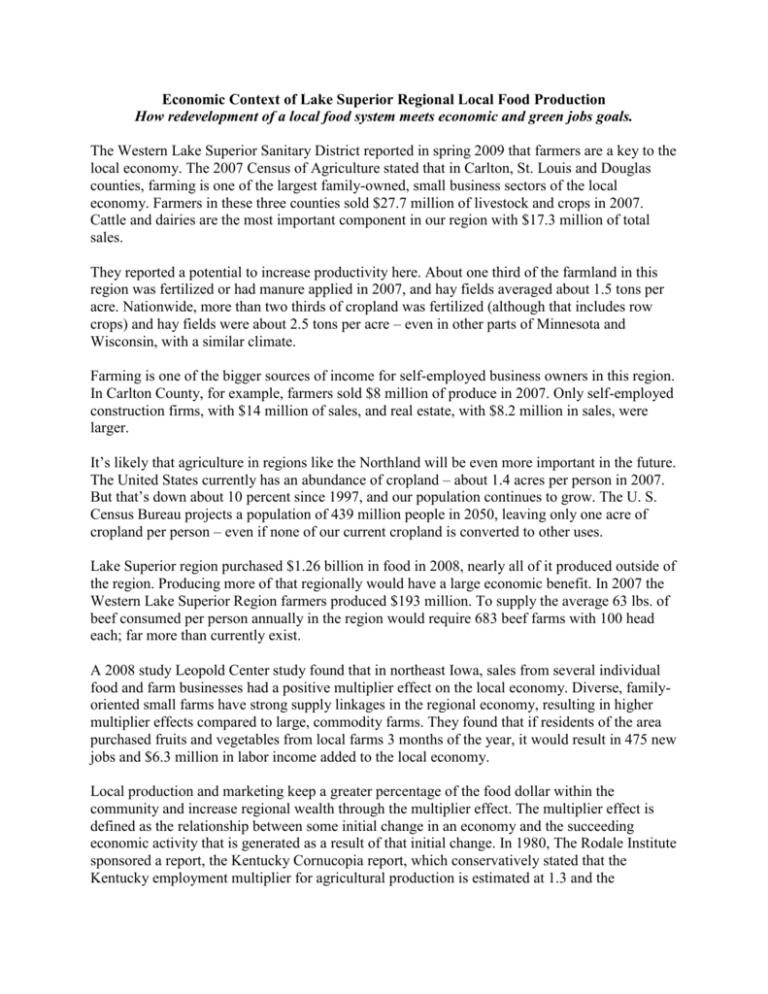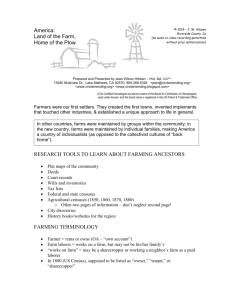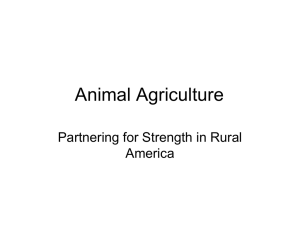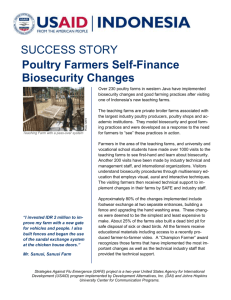Economic Context of Lake Superior Regional Local Food Production
advertisement

Economic Context of Lake Superior Regional Local Food Production How redevelopment of a local food system meets economic and green jobs goals. The Western Lake Superior Sanitary District reported in spring 2009 that farmers are a key to the local economy. The 2007 Census of Agriculture stated that in Carlton, St. Louis and Douglas counties, farming is one of the largest family-owned, small business sectors of the local economy. Farmers in these three counties sold $27.7 million of livestock and crops in 2007. Cattle and dairies are the most important component in our region with $17.3 million of total sales. They reported a potential to increase productivity here. About one third of the farmland in this region was fertilized or had manure applied in 2007, and hay fields averaged about 1.5 tons per acre. Nationwide, more than two thirds of cropland was fertilized (although that includes row crops) and hay fields were about 2.5 tons per acre – even in other parts of Minnesota and Wisconsin, with a similar climate. Farming is one of the bigger sources of income for self-employed business owners in this region. In Carlton County, for example, farmers sold $8 million of produce in 2007. Only self-employed construction firms, with $14 million of sales, and real estate, with $8.2 million in sales, were larger. It’s likely that agriculture in regions like the Northland will be even more important in the future. The United States currently has an abundance of cropland – about 1.4 acres per person in 2007. But that’s down about 10 percent since 1997, and our population continues to grow. The U. S. Census Bureau projects a population of 439 million people in 2050, leaving only one acre of cropland per person – even if none of our current cropland is converted to other uses. Lake Superior region purchased $1.26 billion in food in 2008, nearly all of it produced outside of the region. Producing more of that regionally would have a large economic benefit. In 2007 the Western Lake Superior Region farmers produced $193 million. To supply the average 63 lbs. of beef consumed per person annually in the region would require 683 beef farms with 100 head each; far more than currently exist. A 2008 study Leopold Center study found that in northeast Iowa, sales from several individual food and farm businesses had a positive multiplier effect on the local economy. Diverse, familyoriented small farms have strong supply linkages in the regional economy, resulting in higher multiplier effects compared to large, commodity farms. They found that if residents of the area purchased fruits and vegetables from local farms 3 months of the year, it would result in 475 new jobs and $6.3 million in labor income added to the local economy. Local production and marketing keep a greater percentage of the food dollar within the community and increase regional wealth through the multiplier effect. The multiplier effect is defined as the relationship between some initial change in an economy and the succeeding economic activity that is generated as a result of that initial change. In 1980, The Rodale Institute sponsored a report, the Kentucky Cornucopia report, which conservatively stated that the Kentucky employment multiplier for agricultural production is estimated at 1.3 and the multiplier for local food processing is 1.5, and these figures are still considered reasonable. Thus, 10 new farm jobs in Kentucky would generate three additional jobs in the farm service sector of the local economy, and 10 new local processing jobs would generate six additional jobs in the community. An income multiplier effect also applies to regional cash generation. According to these multipliers, every $1,000 increase in net farm income would generate an additional $930 of income in the community, creating a total of $1930 of new wealth. Using these multipliers, the Cornucopia report estimated that the high level of food imports in 1980 cost Kentucky 126,000 jobs. Current estimates find that if Kentucky were to raise its per farm average direct marketing sales to the national average, it would generate an additional farm-level income of $7.9 million and have an estimated statewide economic impact of $15.8 million. A significant part of the multiplier effect is that local farm owners are generally more likely to spend their money on community goods and services. Anthropologist Walter Goldschmidt, in his groundbreaking study of two communities in California (one surrounded by small-scale family farms, another encircled by large corporate farms) found that, “in towns surrounded by family farms, the income circulated among local business establishments, generating jobs and community prosperity. Where family farms predominated, there were more local businesses…” Moreover, small farms actually have a greater total output than larger farms, meaning that when all goods produced on the farm are considered (not simply yield per single crop type), small farms produced more. Small organic farms also generally hire more people than large factory farms, thus creating more jobs. These farms commonly require between 20 percent and 100 percent more labor than a large conventional farm. Other economic benefits include greater support of community food retailers and distribution networks, including farmers’ markets and community supported agriculture projects, as well as the indirect economic benefit of increased biodiversity. Local food systems are vital components of local economies. Locally based economic development focuses on the particular assets and needs of a region. Like local food systems, local economies build wealth by circulating dollars within a community. Local economies also spur creativity and entrepreneurship by providing people with opportunities to use their skills and talents to establish vibrant businesses. Community-based economic systems are more receptive to the needs of the local people they serve, by having a real stake in the prosperity of the area. In addition, local economic infrastructure helps communities withstand fluctuations in the global economy. Cyclical economic downturns are buffered by strong regional business relationships. Part and parcel of local economies, family farms generate viable and stable affluence that addresses the needs of ordinary people first. In addition, much tax forfeit land could be brought onto the tax rolls with increased local food production enterprises. Food System Work Group Members Chair Randel Hanson, UMD John Fisher Merritt, Food Farm Cree Bradley, Lake Superior Farm Beginnings Stacey Stark, UMD David Abazs, Round River Farm Sarah Hannigan, Northern Communities Land Trust Mimi Stender, Fit City Duluth Brendan Hanschen, NHS Duluth Nan Stubenvoll, Duluth LISC Mary Dragich, Lake Superior Slow Food Jamie Harvie, Institute for a Sustainable Future Lee Ann Tomczyk, Saint Luke’s Dave & Sue Ann Dumke, Brule River Farm Tracy Meisterheim, Sustainable Twin Ports Nicole Wilde, Community Garden Rebecca Ellenson, SOAR Angie Miller, Community Action Duluth Educational Liaisons: Kristin Stuchis, Joe Everett, Sharon Murphy, Glenn D’Amour, Jennifer Madole, Kelly Smith, farmer






